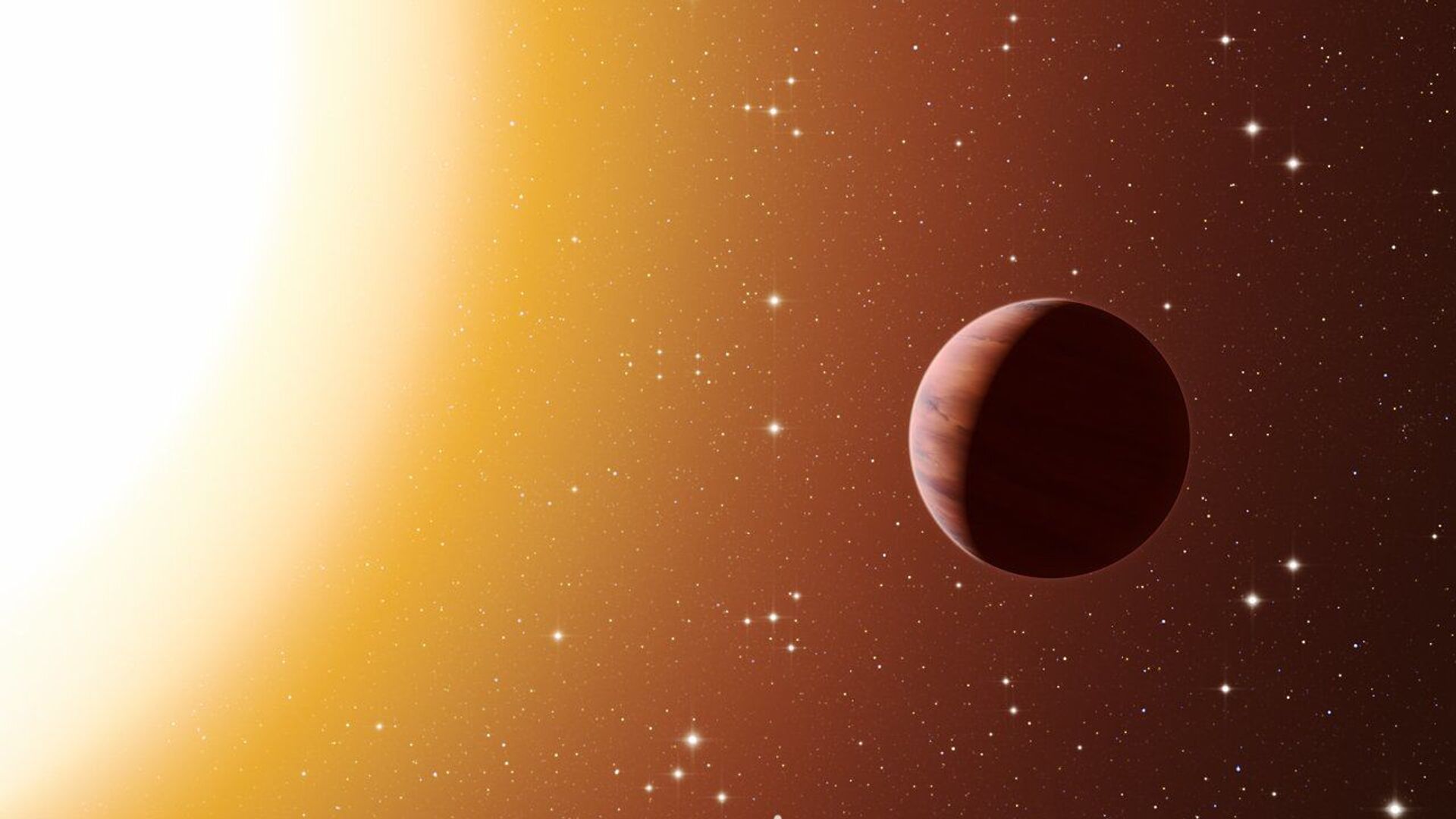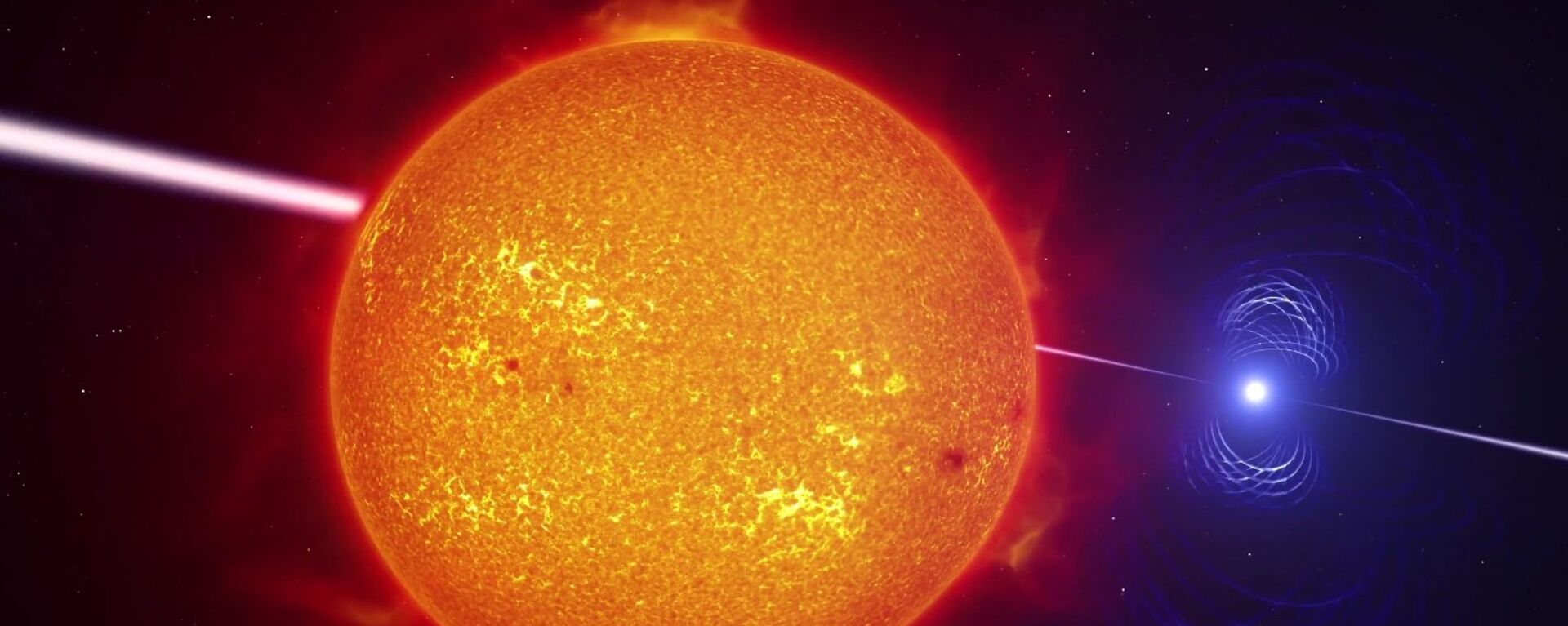https://sputnikglobe.com/20230831/astronomers-spot-exoplanet-with-longest-orbit-yet-1113029514.html
Astronomers Spot Exoplanet With Longest Orbit Yet
Astronomers Spot Exoplanet With Longest Orbit Yet
Sputnik International
A group of astronomers hunting planets beyond our solar system have continued to push the envelope of detectable types of planets using our limited technology, which favors spotting big worlds that orbit close to their stars.
2023-08-31T20:17+0000
2023-08-31T20:17+0000
2023-08-31T20:15+0000
beyond politics
transiting exoplanet survey satellite (tess)
exoplanet
jupiter
astronomy
https://cdn1.img.sputnikglobe.com/img/107969/69/1079696965_0:80:1280:800_1920x0_80_0_0_94e6df44ba4ffe7f0cb29872c53b93c8.jpg
The latest exoplanet find by astronomers was recently identified as TOI-4600c, a Saturn-sized world about 815 light-years from Earth. According to the published findings, TOI-4600c orbits its parent star further away than any other exoplanet ever spotted by humans, and is among the coldest we have spotted as well.The alien world was detected using NASA’s Transiting Exoplanet Survey Satellite (TESS), a space telescope that took over the exoplanet-hunting mission after the Kepler telescope was retired in 2018.The star has another planet even closer, dubbed TOI-4600b, which is between the sizes of Neptune and Saturn and orbits the star every 82.69 days, with a surface temperature of about 170 degrees Fahrenheit (70.67 degrees Celsius).By comparison, Jupiter, which takes 12 Earth years to complete a single orbit, has a surface temperature of negative 238 Fahrenheit (negative 150 Celsius). Thus, when gas giants are found to be orbiting closer to their parent stars and have much higher surface temps, astronomers dub them “warm” or “hot” Jupiters, with the latter typically being so close to their star that they become tidally locked, zipping around the star in just a few Earth hours or days at most.TOI-4600b and c are both considered “warm” Jupiters, but are among the coldest yet found. TESS and other exoplanet-hunting telescopes have also spotted rocky, Earth-like worlds with even colder surface temperatures.Ismael Mireles, a graduate student at the University of New Mexico and the lead author of the study, said in a statement that astronomers were particularly excited about the find because "based on what we know about the exoplanets we found, so far, nothing really looks like the solar system," with a group of inner rocky worlds and the gas giants orbiting further out. "So we want to find out how these different types of systems formed and migrated.""We're used to seeing hot Jupiters that are close in to their stars, and we usually don't find companions to them, let alone giant companions,” she said. “This system is a more unique configuration."The team's paper was published on Wednesday in The Astrophysical Journal Letters.
https://sputnikglobe.com/20230612/astronomers-spot-two-tatooine-like-exoplanets-orbiting-twin-suns-1111096308.html
Sputnik International
feedback@sputniknews.com
+74956456601
MIA „Rossiya Segodnya“
2023
News
en_EN
Sputnik International
feedback@sputniknews.com
+74956456601
MIA „Rossiya Segodnya“
Sputnik International
feedback@sputniknews.com
+74956456601
MIA „Rossiya Segodnya“
exoplanet; tess; warm jupiter; astronomy
exoplanet; tess; warm jupiter; astronomy
Astronomers Spot Exoplanet With Longest Orbit Yet
A group of astronomers hunting planets beyond our solar system - that is, exoplanets - have continued to push the envelope of detectable types of planets using our limited technology, which presently favors spotting big worlds that orbit close to their parent stars.
The latest exoplanet find by astronomers was recently identified as TOI-4600c, a Saturn-sized world about 815 light-years from Earth.
According to the published findings, TOI-4600c orbits its parent star further away than any other exoplanet ever spotted by humans, and is among the coldest we have spotted as well.
The alien world was detected using NASA’s Transiting Exoplanet Survey Satellite (TESS), a space telescope that took over the exoplanet-hunting mission after the Kepler telescope was retired in 2018.
TOI-4600c orbits its star, a K-type orange dwarf star, every 482.82 Earth days, or roughly 16 Earth months. Further, its temperature is a frigid negative 110 degrees Fahrenheit (negative 78 degrees Celsius).
The star has another planet even closer, dubbed TOI-4600b, which is between the sizes of Neptune and Saturn and orbits the star every 82.69 days, with a surface temperature of about 170 degrees Fahrenheit (70.67 degrees Celsius).
By comparison, Jupiter, which takes 12 Earth years to complete a single orbit, has a surface temperature of negative 238 Fahrenheit (negative 150 Celsius). Thus, when gas giants are found to be orbiting closer to their parent stars and have much higher surface temps, astronomers dub them “warm” or “hot” Jupiters, with the latter typically being
so close to their star that they become tidally locked, zipping around the star in just a few Earth hours or days at most.
According to science-oriented media reports, most exoplanets that Earthlings have spotted so far have orbital periods of less than 40 days, meaning most gas giants fall into the warm or hot Jupiter category.
TOI-4600b and c are both considered “warm” Jupiters, but are among the coldest yet found. TESS and other exoplanet-hunting telescopes have also spotted
rocky, Earth-like worlds with even colder surface temperatures.
Ismael Mireles, a graduate student at the University of New Mexico and the lead author of the study, said in a statement that astronomers were particularly excited about the find because "based on what we know about the exoplanets we found, so far, nothing really looks like the solar system," with a group of inner rocky worlds and the gas giants orbiting further out. "So we want to find out how these different types of systems formed and migrated."
Katharine Hesse, a technical staff member at MIT's Kavli Institute for Astrophysics and Space Research and one of the co-authors, added it was “relatively rare” to find two “giant planets” in the same star system.
"We're used to seeing hot Jupiters that are close in to their stars, and we usually don't find companions to them, let alone giant companions,” she said. “This system is a more unique configuration."
The team's paper was
published on Wednesday in The Astrophysical Journal Letters.



